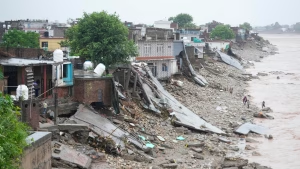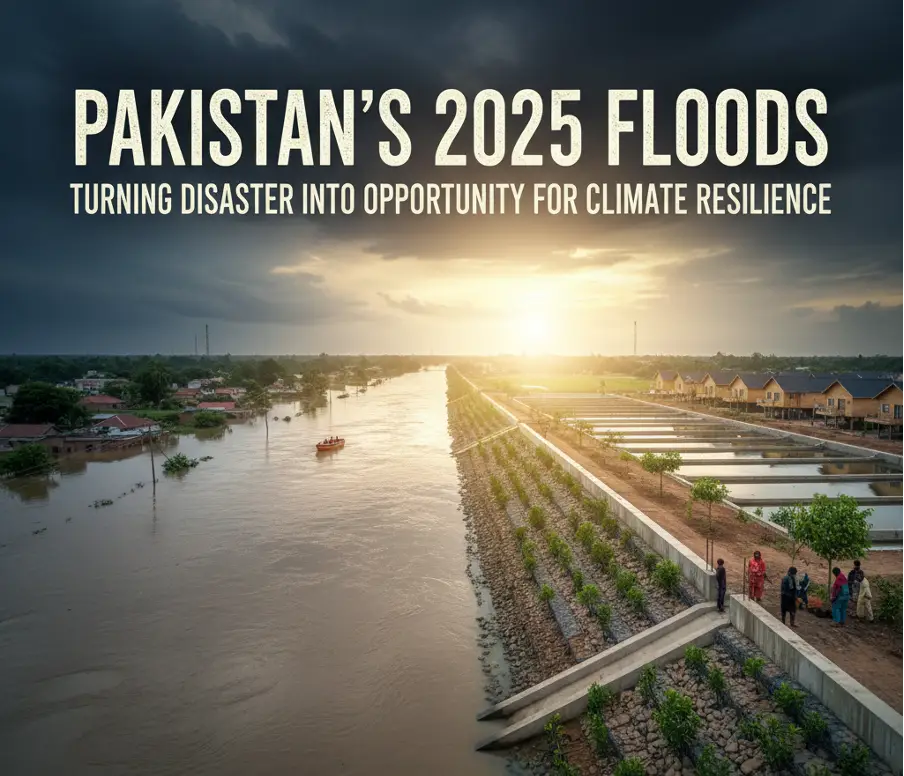Pakistan 2025 Floods: A Strategic Blueprint for Climate-Resilient Development
By: Dr. Ghulam Mohey-ud-din
Executive Summary
Pakistan’s 2025 monsoon floods represent a catastrophic confluence of climate change, environmental degradation, and governance failures. With over 1,000 lives lost, millions displaced, and billions in economic damage, the disaster has laid bare the country’s profound vulnerability. The analysis within this report argues that a business-as-usual approach is no longer tenable. The 2025 floods must be reframed as an existential turning point, demanding a strategic pivot from reactive disaster management to proactive, integrated climate adaptation. This blueprint outlines a comprehensive approach spanning water management, resilient infrastructure, policy reform, and community-level empowerment. A critical element of this analysis is that while the meteorological drivers are external, the disaster’s scale is a direct consequence of vulnerabilities created by human activity. Long-term solutions require an integrated approach that leverages international partnerships to not just finance reconstruction but to fundamentally reform governance, planning, and public awareness.
1. The Pakistan 2025 Floods: A Dissection of a Catastrophe
This section details the scale and drivers of the disaster, moving beyond a simple recounting of events to establish the complex interplay of factors that turned a weather event into a national calamity.
1.1. The Unprecedented Scale of the Disaster
The 2025 monsoon season delivered a devastating and widespread blow in shape Pakistan 2025 floods. According to official figures from the National Disaster Management Authority (NDMA), the human toll was severe, with 1,006 people killed and 1,063 injured nationwide as of late September [1]. The highest number of fatalities were reported in Khyber Pakhtunkhwa (KP) with 504 deaths, followed by Punjab with 304 [1, 2]. The humanitarian impact extended to the country’s most vulnerable populations, with UNICEF reporting the deaths of 255 children and injuries to 320 across the country [2]. Over 2.5 million people were displaced, with many seeking refuge in government-run camps or with host families already strained to their limits [3]. The immense scale of the crisis necessitated massive rescue operations, with over 2.8 million people evacuated in Punjab alone [1, 4].

The infrastructural and economic damage was comprehensive, impacting both rural and urban areas. The NDMA reported that 12,569 homes were affected, with 4,128 completely destroyed [1]. Critical infrastructure was also lost, including 239 bridges and nearly 2,000 kilometers of roads, which hampered relief efforts and isolated communities [1, 3]. Beyond the physical destruction, the economic consequences were staggering. The agricultural heartland of Punjab, often referred to as Pakistan’s “breadbasket,” was particularly hard-hit, with 1.8 million acres of farmland inundated [5]. The Pakistan Business Forum estimated that flash floods destroyed 60% of rice crops, 30% of sugarcane, and 35% of cotton fields [6]. These agricultural losses, valued at up to $3.53 billion, directly threaten national food security and erode the country’s export revenues [5]. The effects rippled through the economy, disrupting industrial centers like Sialkot, a hub for textiles, due to shortages of raw materials like cotton [5].
1.2. A Warning Ignored: The Drivers of Devastation
The sheer scale of the Pakistan 2025 floods cannot be attributed to a singular weather event. The catastrophe was the result of a complex interplay of global climate patterns and domestic, human-driven vulnerabilities.
1.2.1. Climate Change as a Threat Multiplier
The Pakistan 2025 floods are not an isolated occurrence but a clear manifestation of a troubling pattern intensified by climate change. The monsoon season was “unprecedented in intensity,” with rainfall reaching 70–80% above normal in Balochistan and 50–60% higher than average in Punjab [User Query]. Climate scientists confirm that a warming planet leads to more erratic and intense rainfall events because warmer air holds more moisture from the Indian Ocean, which is then dumped all at once when storms develop [7]. This phenomenon is compounded by the unprecedented melting of Pakistan’s 13,000+ glaciers in the Hindu Kush and Himalayan ranges. The gradual rise in temperatures accelerates glacial melt, which, when combined with concentrated rains, heightens the risk of flash floods and catastrophic Glacial Lake Outburst Floods (GLOFs) [7, 8, 9].
1.2.2. The Land’s Revenge: Environmental Degradation
While the meteorological drivers of the floods are global, their devastating impact is a direct result of decades of systemic environmental degradation within Pakistan. The country, classified as “forest-deprived” with only 5% of its total land area covered by forests, loses an estimated 11,000 hectares of forest cover annually [10]. Experts argue that this extensive deforestation has reduced the land’s natural capacity to absorb rainfall, effectively transforming the upper regions into what are being called “flood factories” [11].
Beyond deforestation, “unplanned urbanization and encroachments” on natural riverbeds, wetlands, and floodplains have eliminated vital natural buffers [9, 12, 13]. As one water resource expert has stated, “Floods are ‘acts of God,’ but flood losses are largely acts of man” [9]. This highlights a fundamental relationship: intensified rainfall, driven by global climate change, meets a landscape with diminished natural defenses and overwhelmed human-built infrastructure. The result is a severe weather event amplified into a multi-billion dollar catastrophe, exposing the country’s deep-seated systemic weaknesses.
Table 1: Key Impacts of the 2025 Floods (as of late September)
| Impact Category | Key Metrics | Source Data |
| Human Toll | Fatalities: >1,000 [1] Injuries: 1,063 [1] Displaced: 2.5 million [3] Children’s Deaths: 255 [2] | NDMA, UN, UNICEF [1, 2, 3] |
| Infrastructural Damage | Homes Affected: 12,569 [1] Bridges Destroyed: 239 [1] Roads Damaged: ~2,000 km [1, 3] | NDMA [1, 3] |
| Economic & Agricultural | Farmland Inundated: 1.8 million acres [5] Agricultural Losses: up to $3.53 billion [5] Crops Destroyed: 60% rice, 30% sugarcane, 35% cotton [6] | Pakistan Business Forum, Reuters [5, 6] |
2. The Ripple Effect: Socio-Economic and Human Consequences
The 2025 floods have triggered a series of compounding crises, highlighting the second- and third-order impacts on the economy, public health, and social fabric.
2.1. A Blow to the Economy and Food Security
The floods have delivered a severe blow to Pakistan’s agricultural sector, a cornerstone of its economy and foreign exchange earnings [6]. The catastrophic destruction of vital crops has led to a dual problem: domestic food shortages and a potential collapse of key export markets. Prices for essential food items like wheat, sugar, onions, and tomatoes have already surged, pushing a sensitive price index to a 26-month high [5]. A former finance minister warned that the disaster will increase the current account deficit by $7 billion, a significant setback for the nation’s fragile economic recovery [4].
The economic impact extends far beyond initial monetary damage, creating a cascading effect across the country’s supply chains. The agricultural crisis has a direct and severe ripple effect on the manufacturing sector. The widespread cotton shortfall will have a “ripple effect” on the textile sector, which serves as the country’s top foreign exchange earner [5]. Industrial hubs like Sialkot, known for their textile and sporting goods industries, were directly affected by the disruption [5]. Similarly, rice exporters are concerned that crop shortages will lead to higher prices, causing Pakistan to lose its competitive edge against India in the international market [5, 6]. The disruption demonstrates how a single disaster can jeopardize an entire economic trajectory, as the hit to one sector creates a chain reaction of instability across the nation’s fiscal and trade landscape.
2.2. A Crisis of Public Health and Mental Well-being
In the immediate aftermath of the floods, stagnant water created a perfect breeding ground for disease outbreaks. Health officials and humanitarian agencies have warned of potential outbreaks of waterborne diseases, including cholera, dengue, and malaria, mirroring the health crises witnessed in 2022 [8, 14, 15]. Access to healthcare has been critically compromised, with more than 888 health facilities damaged and 88 completely destroyed in the floods [15]. This has left millions of people without access to the medical care and treatment they desperately need [15].
The humanitarian crisis is not limited to physical survival but includes a long-term, unaddressed mental health emergency. Psychiatrists have reported a surge in “acute stress disorders” and a high risk of Post-Traumatic Stress Disorder (PTSD) among survivors grappling with the loss of loved ones and property [16]. Many victims are experiencing sleepless nights and persistent feelings of grief and anxiety, which can lead to major psychiatric problems if left untreated [16]. This critical gap in the disaster response system is particularly acute for women and children. Women are more prone to PTSD but are often prevented from seeking help due to social taboos [16]. Children are a particularly vulnerable group. The trauma of displacement, loss of parents, and disruption of their education has led to severe psychosocial distress, anger, fear, and panic attacks [2, 17]. Researchers have even coined the term “Environmentally driven Adverse Childhood Experiences (E-ACEs)” to describe the severe stressors children face, which can impair brain development and increase their vulnerability to long-term health risks [17]. While the government and aid agencies have been effective at physical rescue and relief efforts [3], the critical failure to provide long-term, systematic psychosocial support leaves lasting scars and undermines the very communities they seek to rebuild.
3. Policy and Governance: A Framework for Change
This section critically evaluates Pakistan’s current policy framework, contrasting traditional approaches with a new, integrated paradigm and identifying key implementation challenges.
3.1. The Debate on Engineered Solutions: Dams and Defenses
Pakistan’s traditional approach to flood management has centered on large-scale engineering projects. Mega-dams like Diamer-Bhasha and Mohmand are central to the government’s long-term water management strategy, offering multi-purpose storage and flood regulation [18, 19]. The Mohmand Dam is scheduled for completion in 2027-28 and is expected to mitigate flood risks for downstream districts [20]. The Diamer-Bhasha Dam, set for completion in 2028, is a massive project designed to store 8.1 MAF of water and generate 4,500 MW of clean electricity [21, 22].
Despite their stated benefits, these mega-projects are not a panacea. The stalled Kalabagh Dam is a prime example of the political challenges, stalled by fierce inter-provincial disputes over water rights and fears of displacement and flooding [23]. Furthermore, experts caution that large dams are an “old technique” that can create a “false sense of security” by encouraging development in floodplains that would have otherwise been avoided [23, 24]. When extreme rainfall events overwhelm the dam’s capacity, the consequences can be even more catastrophic [24]. A growing consensus of experts advocates for a shift away from a singular focus on mega-dams toward a portfolio of solutions, including smaller, decentralized water storage systems and the restoration of traditional irrigation canals [24].
3.2. A New Paradigm: Integrated and Nature-Based Solutions
A new strategic approach to flood management is gaining traction, one that shifts from fighting floods with concrete to “living with floods” by making space for rivers to flow naturally [9]. This concept is inspired by international models like the Netherlands’ “Room for the River” program, which involves widening riverbeds, creating flood channels, and relocating dykes further inland [25, 26].
This new paradigm emphasizes a combination of engineering and nature-based strategies. This includes catchment reforestation, wetland restoration, and coastal mangrove preservation, which can slow runoff, absorb excess water, and buffer storm surges [9, 27]. A 2023 Dutch white paper also stressed an integrated resilience approach through three methods: water “reuse” (for groundwater recharge), “retention” (via cross-drainage and channels), and “removing” (making space for the river) [9]. Urban areas, too, require a systemic change, with the need for modernized drainage systems and the enforcement of new building codes that mandate “rainwater harvesting provisions” and promote urban afforestation [28, 29, 30].
Table 2: A Comparison of Flood Management Strategies
| Strategy | Advantages | Disadvantages |
| Structural Measures (e.g., Mega-Dams) | Offers large-scale water storage and hydropower generation [19, 21] Provides a sense of security for downstream communities [24] | Politically controversial and prone to inter-provincial disputes [23] Can create a false sense of security, encouraging development in risky areas [24] May exacerbate downstream flooding if capacity is exceeded [23] |
| Nature-Based Solutions (e.g., Reforestation, Wetlands) | Restores natural absorption and drainage capacities [9, 27] Supports biodiversity and provides ecological benefits [User Query] Less prone to large-scale failures [24] | Requires long-term commitment and land-use changes [9] Not a singular solution for extreme, concentrated floods [23, 24] Can be difficult to enforce against human encroachment [9] |
The core problem in Pakistan’s disaster management is not a lack of policy, but a systemic failure in its implementation and enforcement. The NDMA has developed a “comprehensive and forward-looking” National Disaster Management Plan (NDMP) 2025, along with a Monsoon Contingency Plan [31, 32]. Despite these well-intentioned documents, multiple reports highlight “weak implementation of flood risk management policy at the district level” and a general lack of preparedness as foundational barriers [33, 34, 35]. This reveals a profound disconnect between top-down planning and bottom-up execution. Political instability and a lack of legislative and resource support for District Disaster Management Authorities (DDMAs) undermine the entire system [33, 34]. The public debate over mega-dams, while a natural response to disaster, can be seen as a distraction from the politically difficult but necessary actions of enforcing floodplain zoning and curbing unplanned settlements—measures that directly address the root causes of vulnerability [9].
4. A Path Forward: Recommendations for a Resilient Pakistan
The 2025 floods provide a unique, if tragic, window of opportunity to fundamentally re-evaluate Pakistan’s relationship with its environment. The following recommendations offer a strategic blueprint for national and international stakeholders to pivot from a cycle of recurring disasters to a future of sustainable, climate-resilient development.
4.1. Strategic Recommendations on Water Management and Infrastructure
- Adopt a National Integrated Water Management Strategy: A comprehensive, system-wide approach to water governance is required. This should include rainwater harvesting, groundwater recharge via small floodwater retention basins (“talaabs”), and the rehabilitation of traditional irrigation systems to transform floodwaters from a hazard into a resource
[User Query]. - Prioritize a Portfolio of Solutions: The focus on a few mega-dams must be rebalanced with a portfolio of smaller-scale, decentralized projects. This approach, while less dramatic, can store water for agricultural and domestic use, is less prone to political disputes, and is more adaptable to local needs
[24]. - Modernize Hydraulic Infrastructure: The existing network of rural embankments and urban drainage systems must be strengthened and upgraded. This should be complemented by modern technology, including AI forecasting and automated barrage gates, to improve real-time flood regulation
[9].
4.2. Policy and Governance Recommendations
- Establish and Enforce Floodplain Zoning: A national policy must be immediately legislated and enforced to prohibit new construction on floodplains and riverbeds. This requires the political will to confront encroachment and should be paired with incentives for communities to relocate from high-risk zones
[9, 29, 30, 35]. - Empower District Disaster Management Authorities (DDMAs): The weakest link in the disaster management chain is the lack of support for DDMAs. The NDMA’s plan to decentralize disaster management must be fully realized by providing DDMAs with increased legislative and resource support
[33, 34]. - Strengthen Early Warning and Communication: While warning systems have improved
[9], they remain a significant challenge. Warnings must reach rural and low-literacy communities in a timely and effective manner. This requires expanding communication channels to include community radio, text message alerts, and local language broadcasts, while also ensuring better coordination between all involved groups[9, 30].
4.3. Community-Level Resilience and Human Capital Recommendations
- Invest in Flood-Resistant Agriculture and Livelihoods: Support for farmers must go beyond relief aid to include tools for long-term resilience, such as flood-resistant crops and resilient irrigation techniques. Livelihood diversification programs, such as aquaculture in flood-prone areas, can help protect food security and build economic resilience
[User Query]. - Implement a Comprehensive Psychosocial Support Program: The mental health crisis must be recognized as a core component of disaster response. Long-term counseling, psychotherapy, and occupational therapy programs for survivors, with a special focus on children and women, should be scaled up to address this profound and lasting toll
[16, 17]. - Build a Decentralized, Community-Based Framework: Empowering local communities with resources and training for preparedness and rescue is essential. This fosters a bottom-up, sustainable approach to disaster management that is more responsive and effective than a top-down model alone
[36].
4.4. International Cooperation and Funding Recommendations
- Pivot from Short-Term Aid to Long-Term Partnerships: International financial support must evolve from emergency relief to long-term investment in climate-resilient infrastructure and governance reform
[37, 38]. The World Bank’s emphasis on aid being most effective when coupled with a government’s commitment to economic reforms[37]is a critical lesson. This approach transforms aid from a handout into a catalyst for fundamental structural change. - Leverage International Expertise for a Paradigm Shift: Pakistan should engage more deeply with nations that have mastered integrated water management, such as the Netherlands
[9, 39, 40]. The focus should be on institutional and conceptual capacity-building, learning to “live with floods” and embracing nature-based solutions. The 2025 floods provide a unique, if tragic, window of opportunity to build political consensus around this new, more sustainable paradigm.
Conclusion: Turning Crisis into Opportunity
The 2025 floods are an unambiguous signal of Pakistan’s intertwined climate, environmental, and governance vulnerabilities. They underscore a stark reality: in a warming world, foresight, preparedness, and integrated planning are no longer optional—they are existential imperatives. By adopting this strategic blueprint, Pakistan can move beyond the recurring cycle of disaster and recovery. The moment is ripe for action, and the lessons of 2025 must serve as a catalyst for a proactive, long-term, and climate-resilient future.










Leave a Reply